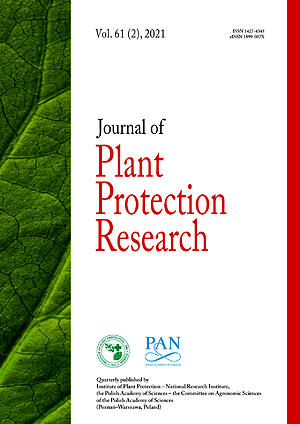RAPID COMMUNICATION
Bacterial watermark disease on Salix alba caused by Brenneria salicis in Iran
1
Department of Plant Pathology, Vali-e-Asr University of Rafsanjan, Rafsanjan, Iran
2
Department of Plant Pathology, Ferdowsi University of Mashhad, Mashhad, Iran
A - Research concept and design; B - Collection and/or assembly of data; C - Data analysis and interpretation; D - Writing the article; E - Critical revision of the article; F - Final approval of article
Submission date: 2020-11-08
Acceptance date: 2021-01-20
Online publication date: 2021-06-19
Corresponding author
Pejman Khodaygan
Department of Plant Pathology, Vali-e-Asr University of Rafsanjan, Rafsanjan, 22 bahman, 7718897111, Rafsanjan, Iran
Department of Plant Pathology, Vali-e-Asr University of Rafsanjan, Rafsanjan, 22 bahman, 7718897111, Rafsanjan, Iran
Journal of Plant Protection Research 2021;61(2):195-199
KEYWORDS
TOPICS
ABSTRACT
In 2016, bacterial canker symptoms, often with dried ooze, were observed on Salix alba
plants in municipal lands and parks in Kerman and Fars provinces, Iran. To determine the
causative agent, samples were collected from symptomatic trees, and macerates of the affected
bark tissues were plated on sucrose nutrient agar (SNA). Ten isolates were identified
by phenotypic characterization, pathogenicity tests, and two of them further confirmed
identity using sequence analysis of the partial of 16S rRNA and gyrB genes, and phylogenetic
analysis. The isolates showed the highest identity (99–100%) with Brenneria salicis. To
our knowledge, this is the first report of watermark disease on S. alba caused by B. salicis
in Iran.
FUNDING
This research was supported by the Vice Chancellor
of Research and Technology grant (AGR95PP5938) at
the Vali-E-Asr University of Rafsanjan, Iran.
CONFLICT OF INTEREST
The authors have declared that no conflict of interests exist.
REFERENCES (17)
1.
Ausuble F., Brent F.M., Kingestone R.E., Moor D.D., Smith J.A., Seideman J.G., Struhl K. 1992. Current Protocols in Molecular Biology. Greene, Publishing Associates, Wiley Interscience, New York, USA, 4648 pp.
2.
Basavand E., Khodaygan P., Babaeizad V., Rahimian H., Mirhosseini H. 2020. Soft rot disease caused by Klebsiella aerogenes on Austrocylindropuntia subulata in Iran. Indian Phytopathology 73: 371–372. DOI: https://doi.org/10.1007/s42360....
3.
Borkar S.G. 2017. Laboratory Techniques in Plant Bacteriology. CRC Press, New York, USA, 320 pp.
4.
Brady C.L., Cleenwerck I., Denman S., Venter S.N., Rodríguez-Palenzuela P., Coutinho T.A., De Vos P. 2012. Proposal to reclassify Brenneria quercina (Hildebrand and Schroth 1967) Hauben et al. 1999 into a new genus, Lonsdalea gen. nov., as Lonsdalea quercina comb. nov., descriptions of Lonsdalea quercina subsp. quercina comb. nov., Lonsdalea quercina subsp. iberica subsp. nov. and Lonsdalea quercina subsp. britannica subsp. nov., emendation of the description of the genus Brenneria, reclassification of Dickeya dieffenbachiae as Dickeya dadantii subsp. dieffenbachiae comb. nov., and emendation of the description of Dickeya dadantii. International Journal of Systematic and Evolutionary Microbiology 62 (7): 1592–1602. DOI: https://doi.org/10.1099/ijs.0.....
5.
Brady C., Cleenwerck I., Venter S., Vancanneyt M., Swings J., Coutinho T. 2008. Phylogeny and identification of Pantoea species associated with plants, humans and the natural environment based on multilocus sequence analysis (MLSA). Systematic and Applied Microbiology 31: 447–460. DOI: https://doi.org/10.1016/j.syap....
6.
Denman S., Brady C.L., Kirk S., Cleenwerck I., Venter S.N., Coutinho T.A., De Vos P. 2012. Brenneria goodwinii sp. nov., associated with acute oak decline in the UK. International Journal of Systematic and Evolutionary Microbiology 62: 2451–2456. DOI: https://doi.org/10.1099/ijs.0.....
7.
Grosso S., Mason G., Ortalda E., Scortichini M. 2011. Brenneria salicis associated with watermark disease symptoms on Salix alba in Italy. Plant Disease 95 (5): 772. DOI: https://doi.org/10.1094/PDIS-1....
8.
Hauben L., Moore E.R.B., Vauterin L., Steenackers M., Mergaert J., Verdonck L., Swings J. 1998. Phylogenetic position of phytopathogens within the Enterobacteriaceae. Systematic and Applied Microbiology 21 (3): 384–397.
9.
Huvenne H., Messens E., Maes M. 2009. Willow wood sap promotes the density-dependent pathogenesis of Brenneria salicis. Environmental Microbiology 11 (6): 1463–1472.
10.
Khodaygan P., Habibi H. 2019. Brenneria nigrifluens, a latent threat for walnut trees in Alborz province of Iran. Iranian Journal of Plant Pathology 54 (4): 337–341.
11.
Klement Z., Rudolph K., Sands D.C. 1990. Methods in Phytobacteriology. Akademiai, Kiado, Budapest, 568 pp.
12.
Kumar S., Stecher G., Tamura K. 2016. MEGA7: molecular evolutionary genetics analysis version 7.0 for bigger datasets. Molecular Biology and Evolution 33 (7): 1870–1874. DOI: https://doi.org/10.1093/molbev....
13.
Meas M., Baeyen S., De Croo H., De Smet K., Steenackers M. 2002. Monitoring of endophytic Brenneria salicis in willow and its relation to watermark disease. Plant Protection Science 38: 528–530. DOI: https://doi.org/10.17221/10545....
14.
Meas M., Huvenne H., Messens E. 2009. Brenneria salicis, the bacterium causing watermark disease in willow, resides as an endophyte in wood. Environmental Microbiology 11 (6): 1453–1462. DOI: https://doi.org/10.1111/j.1462....
15.
Sakamoto Y., Takikawa Y., Sasaki K. 2002. Occurrence of watermark disease of willows in Japan. Plant Pathology 48 (5): 613–619. DOI: https://doi.org/10.1046/j.1365....
16.
Schaad N.W., Jones J.B., Chun W. 2001. Laboratory Guide for Identification of Plant Pathogenic Bacteria. APS Press, Minnesota, USA, 410 pp.
17.
Weisburg W.G., Barns S.M., Pelletier D.A., Lane D.J. 1991. 16S ribosomal DNA amplification for phylogenetic study. Journal of Bacteriology 173 (2): 697–703.
We process personal data collected when visiting the website. The function of obtaining information about users and their behavior is carried out by voluntarily entered information in forms and saving cookies in end devices. Data, including cookies, are used to provide services, improve the user experience and to analyze the traffic in accordance with the Privacy policy. Data are also collected and processed by Google Analytics tool (more).
You can change cookies settings in your browser. Restricted use of cookies in the browser configuration may affect some functionalities of the website.
You can change cookies settings in your browser. Restricted use of cookies in the browser configuration may affect some functionalities of the website.




